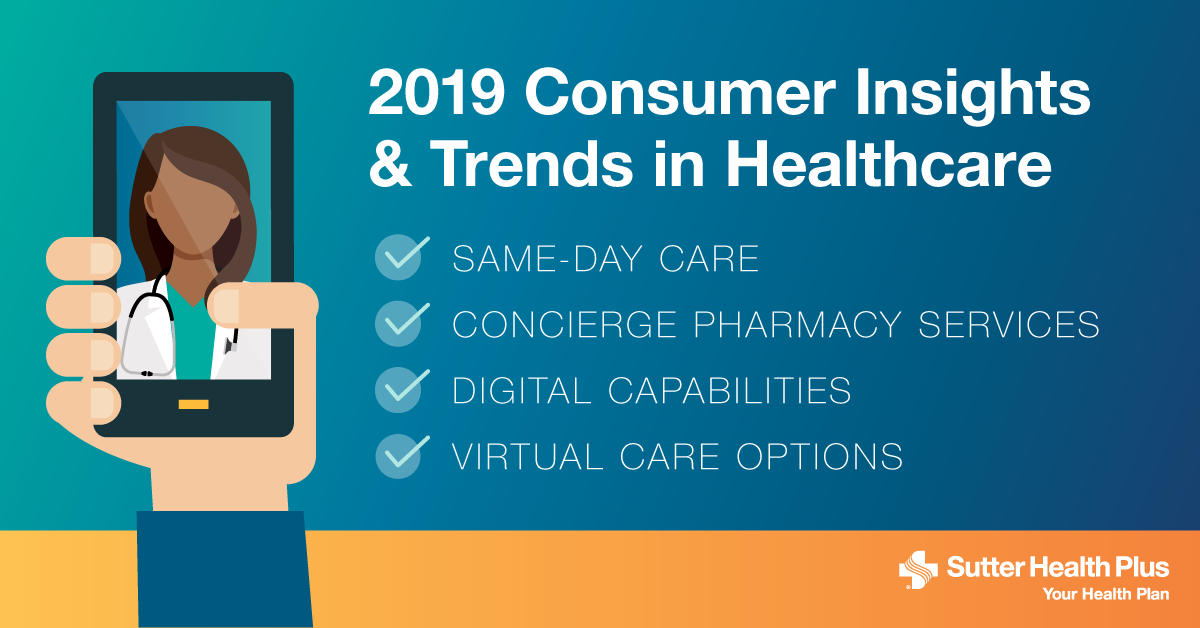
In this article published in the September 17, 2019 issue of BenefitsPRO, Sutter Health Plus Vice President of Sales Rob Carnaroli explains trends in how people shop for and access health care.
As we head into fall open enrollment season, it’s important for brokers to pause and scan the marketplace for their clients. In Northern California, the global center of technology and innovation, we’re seeing clear trends in how people shop for and access health care. The single marketplace differentiator is convenience for consumers.
The traditional ways to access health care, such as driving to a care center for a doctor’s appointment or standing in line at the pharmacy to fill a prescription, are becoming less relevant as modern entry points emerge. In response, the healthcare industry is experiencing accelerated demand to bring convenience and value to consumers. For brokers, keeping a pulse on new and modern ways the industry is responding to consumer demands may lead to more insightful recommendations for their clients. Let’s take a look at the top four ways we are seeing access to healthcare change.
Same-day care
The Amazon effect has changed the game in terms of consumer expectations. People look for goods and services on demand. Why wait several weeks for an appointment with a doctor when you have the option to walk into a neighborhood retail clinic or walk-in care location? These sites are popping up across the country, offering quick and easy access for everyday care needs, including immunizations, allergies and infections. In fact, recent survey data from Accenture suggests that 62 percent of consumers consider the convenience of appointment times as a deciding factor in their satisfaction with health care services.
Video visits are also on the rise, offering same-day care for common illnesses and health needs from the convenience of a home or office. This alternative to a brick-and-mortar setting is ideal for rural residents, busy professionals, or for anyone wanting to avoid traffic and parking hassles. Communicating with a doctor by smartphone, laptop or tablet can often meet a person’s immediate needs, wherever they are.
These same-day care access points are also often available in the evenings and on weekends, when the only other option may be urgent care or emergency services.
Concierge pharmacy services
The same-day demand extends to prescription medications, too. For example, Alto, a Bay Area pharmacy with free same-day delivery service, began as a brick-and-mortar operation over 30 years ago in San Francisco. They now have the home delivery capability of 400 chain pharmacy locations, and their service offers more than just prescription drugs through delivery couriers. Alto’s mobile app can track deliveries, provide reminders to take and refill medications, and allows users to securely message questions to a pharmacist.
Other national chains are also entering the market, some offering fee-for-service same-day pharmacy delivery, and lower-cost options for one to two-day delivery.
Given a choice between waiting in line and the ease of opening the front door, consumers are leaning toward convenience—and the pharmacy industry is taking notice.
Digital capabilities
We live in a digital-first era, where accessing the internet or using a virtual assistant like Alexa is preferred over most other communications vehicles, including the telephone. Consumers expect to be just a few clicks away from finding answers, getting directions, or completing tasks.
According to a recent survey by McKinsey and Company, about 70 percent of consumers want to use digital tools to search for a doctor, pay their bills, schedule appointments, order prescription refills, monitor health metrics, and receive care. The healthcare industry is innovating this space, offering new smartphone apps and digital services to address the needs of today’s consumer, with additional functionality to securely message a care team, look up health and wellness information, and access health plan benefit information.
This year, we’re also seeing integrated artificial intelligence (AI) powered symptom checkers used to expand patient engagement and help with navigating to the appropriate place for care—either physical offices or digital options. Keep an eye out for smart technology to grow as health systems find new ways to reimagine digital touchpoints.
Virtual-first primary care
One of the hottest trends today is the virtual-first primary care model. Virtual-first primary care offers mobile access to a dedicated care team through video visits, phone consultations, email messages, or in-person visits when needed. It’s ideal for active individuals who want convenient primary care that fits their schedule, whether they’re at home, at work, or on the go.
The virtual-first primary care model doesn’t remove the human element. Recently, a Harvard Business Review study found that 74 percent of patients felt telehealth visits improved their relationship with their doctor. This level of access can help reduce the need for in-person appointments, as people can reach out to their care team in real-time to ask questions and treat symptoms as they arise.
Conclusion
Convenience, once a commercial retail concept, is now expected in nearly all aspects of health care. Consumers are increasingly more willing to use new models of care, opening up the doors for innovation to improve access, quality, and affordability—with the goal of leading to improved health outcomes.
By listening to the voice of the consumer through insights and trends, brokers can leverage what sets them apart—their knowledge of the marketplace—and direct clients to the best coverage for their employees.



